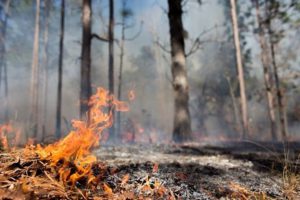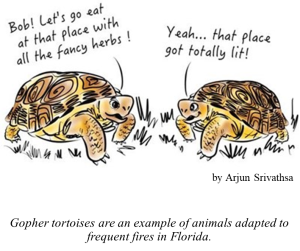 Let’s travel back in time—to an early 16th century summer. You’re standing in an uncut longleaf pine forest in Florida; you have a ¼ mile view in every direction. Yellow and purple flowers dot the landscape of wiregrass, saw palmetto, and blueberry bushes. In one step, you cross over a hundred species of plants. A light fluttering of air passes over you, then you hear the click of feet on bark from the red cockaded woodpecker who landed near you. You glimpse the distant sky where large, indigo thunderheads billow. A cool rush of air sweeps through the forest, causing the pines to sway and creak. A flash of light and simultaneous crackling boom sends the hair on your arms skyward, and you turn to see a smoldering, black scar on a pine tree. Sap begins to ooze from the wound and ignite. It drips down the trunk and lights a nearby wiregrass clump, which is slowly reduced to a black tuft of ankle-high stalks before the fire spreads to the next plant.
Let’s travel back in time—to an early 16th century summer. You’re standing in an uncut longleaf pine forest in Florida; you have a ¼ mile view in every direction. Yellow and purple flowers dot the landscape of wiregrass, saw palmetto, and blueberry bushes. In one step, you cross over a hundred species of plants. A light fluttering of air passes over you, then you hear the click of feet on bark from the red cockaded woodpecker who landed near you. You glimpse the distant sky where large, indigo thunderheads billow. A cool rush of air sweeps through the forest, causing the pines to sway and creak. A flash of light and simultaneous crackling boom sends the hair on your arms skyward, and you turn to see a smoldering, black scar on a pine tree. Sap begins to ooze from the wound and ignite. It drips down the trunk and lights a nearby wiregrass clump, which is slowly reduced to a black tuft of ankle-high stalks before the fire spreads to the next plant.
History of fire
For thousands of years, fire shaped southeastern ecosystems, where low intensity, lightning-ignited fires often spread across pinelands in early summer. These fire-adapted ecosystems need fire for seed dispersal and successful germination; and pre-industrial people used fire as a beneficial tool to manage landscapes. Eventually industrialization demanded more timber products and fire changed forever. By the early 1900s, the logging industry cleared over 80% of the pine forests throughout the Southeastern Coastal Plain. Fires became a safety concern for settlements and cities. “Fire control” was a principle duty of the US Forest Service and government officials encouraged fire suppression in effort to regrow pine forests.
In the absence of fire, however, historic longleaf pine and oak forests became thick hardwood forests, ironically making them more prone to uncontrollable wildfires. Grasses and carnivorous plants disappeared as maples, beech, and hickories replaced oaks. Eventually, as researchers examined the role of fire in these ecosystems, their findings supported the reintroduction of controlled, planned fire to manage land. The first official “prescribed burn” on federal land was in 1943 in Osceola National Forest. Today, prescribed burns help manage habitat for imperiled species, improve habitat for game species, reduce pests, optimize plant growth, and minimize the risk of catastrophic wildfires.
What we have learned
In the last 20 years, the timing of prescribed burns has shifted from winter (“dormant season”) to late spring and summer (“growing season”). Why the shift? In the southeast, thunderstorms and lightning strikes (nature’s “fire-starter”) happen during the growing season. Thus, the plants and animals are adapted to growing season fires; we observe: 1) better control of encroaching hardwoods, 2) increase in the number of flowering plants, 3) more fruiting plants providing food to animals over winter, and 4) improved wildlife habitat. Although many animals have young in late spring and summer, most are able to move out of a burn area or underground before the slow-moving controlled fire reaches them.
the last 20 years, the timing of prescribed burns has shifted from winter (“dormant season”) to late spring and summer (“growing season”). Why the shift? In the southeast, thunderstorms and lightning strikes (nature’s “fire-starter”) happen during the growing season. Thus, the plants and animals are adapted to growing season fires; we observe: 1) better control of encroaching hardwoods, 2) increase in the number of flowering plants, 3) more fruiting plants providing food to animals over winter, and 4) improved wildlife habitat. Although many animals have young in late spring and summer, most are able to move out of a burn area or underground before the slow-moving controlled fire reaches them.
While growing season burns are natural and ecologically important, caution must be used due to higher air temperature and damp fuel. Safety is top priority; with human development often nearby, smoke is the largest concern. Burn managers take every precaution by gauging weather and site conditions before deciding to burn. In Florida, the Florida Forest Service, Florida Water Management Districts, Florida Fish and Wildlife Conservation Commission, National Forests of Florida, and many City and County governments all conduct prescribed burns at various times throughout the year.
Where there’s smoke…
So, next time you see smoke, remember that billowing gray mass might be showcasing the work to restore habitat for wildlife. If you encounter smoke on the highway, slow down and use caution. If you are not sure if it is a prescribed burn or an out-of-control wildfire, you can check this map. For wildfire emergencies, call 911 immediately or contact a local forestry field unit office. Learn about more resources for wildland fire in Florida.
Interested in learning about landscaping to help protect your home from the risk of wildfire? UF/IFAS Extension has a “firescaping” program coming soon, contact Shelly.Johnson@ufl.edu for more information.
Written by Megan Ellis and Shelly Johnson
 1
1
